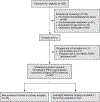Effect of overnight smoking abstinence on a marker for microglial activation: a [11C]DAA1106 positron emission tomography study
- PMID: 30343364
- PMCID: PMC6497451
- DOI: 10.1007/s00213-018-5077-3
Effect of overnight smoking abstinence on a marker for microglial activation: a [11C]DAA1106 positron emission tomography study
Abstract
Rationale: Microglia are the main immune cells in the central nervous system and participate in neuroinflammation. When activated, microglia express increased levels of the translocator protein 18 kDa (TSPO), thereby making TSPO availability a marker for neuroinflammation. Using positron emission tomography (PET) scanning, our group recently demonstrated that smokers in the satiated state had 16.8% less binding of the radiotracer [11C]DAA1106 (a radioligand for TSPO) in the brain than nonsmokers.
Objectives: We sought to determine the effect of overnight smoking abstinence on [11C]DAA1106 binding in the brain.
Methods: Forty participants (22 smokers and 18 nonsmokers) completed the study (at one of two sites) and had usable data, which included images from a dynamic [11C]DAA1106 PET scanning session (with smokers having been abstinent for 17.9 ± 2.3 h) and a blood sample for TSPO genotyping. Whole brain standardized uptake values (SUVs) were determined, and analysis of variance was performed, with group (overnight abstinent smoker vs. nonsmoker), site, and TSPO genotype as factors, thereby controlling for site and genotype.
Results: Overnight abstinent smokers had lower whole brain SUVs (by 15.5 and 17.0% for the two study sites) than nonsmokers (ANCOVA, P = 0.004). The groups did not significantly differ in injected radiotracer dose or body weight, which were used to calculate SUV.
Conclusions: These results in overnight abstinent smokers are similar to those in satiated smokers, indicating that chronic cigarette smoking leads to global impairment of microglial activation which persists into early abstinence. Other explanations for study results, such as smoking leading to reduced numbers of microglia or smokers having more rapid metabolism of the radiotracer than nonsmokers, are also possible.
Keywords: Cigarette withdrawal; Magnetic resonance imaging; Microglial activation; Neuroinflammation; Positron emission tomography; Tobacco dependence; [11C]DAA1106.
Conflict of interest statement
On behalf of all authors, the corresponding author states that there is no conflict of interest.
Figures


Similar articles
-
Effect of Cigarette Smoking on a Marker for Neuroinflammation: A [11C]DAA1106 Positron Emission Tomography Study.Neuropsychopharmacology. 2017 Jul;42(8):1630-1639. doi: 10.1038/npp.2017.48. Epub 2017 Mar 6. Neuropsychopharmacology. 2017. PMID: 28262740 Free PMC article.
-
Effects of Cigarette Smoking and 3-Day Smoking Abstinence on Translocator Protein 18 kDa Availability: A [18F]FEPPA Positron Emission Tomography Study.Addict Biol. 2025 Feb;30(4):e70024. doi: 10.1111/adb.70024. Addict Biol. 2025. PMID: 40184237 Free PMC article.
-
Radiation dosimetry and biodistribution of the translocator protein radiotracer [(11)C]DAA1106 determined with PET/CT in healthy human volunteers.Nucl Med Biol. 2014 Nov-Dec;41(10):871-5. doi: 10.1016/j.nucmedbio.2014.07.004. Epub 2014 Aug 1. Nucl Med Biol. 2014. PMID: 25156039 Free PMC article.
-
Translocator Protein-18 kDa (TSPO) Positron Emission Tomography (PET) Imaging and Its Clinical Impact in Neurodegenerative Diseases.Int J Mol Sci. 2017 Apr 7;18(4):785. doi: 10.3390/ijms18040785. Int J Mol Sci. 2017. PMID: 28387722 Free PMC article. Review.
-
Imaging brain microglial activation using positron emission tomography and translocator protein-specific radioligands.Int Rev Neurobiol. 2011;101:19-39. doi: 10.1016/B978-0-12-387718-5.00002-X. Int Rev Neurobiol. 2011. PMID: 22050847 Review.
Cited by
-
Effects of Antipsychotic Drugs: Cross Talk Between the Nervous and Innate Immune System.CNS Drugs. 2020 Dec;34(12):1229-1251. doi: 10.1007/s40263-020-00765-x. Epub 2020 Sep 25. CNS Drugs. 2020. PMID: 32975758 Review.
-
Essential Principles and Recent Progress in the Development of TSPO PET Ligands for Neuroinflammation Imaging.Curr Med Chem. 2022 Aug 6;29(28):4862-4890. doi: 10.2174/0929867329666220329204054. Curr Med Chem. 2022. PMID: 35352645 Free PMC article. Review.
-
Potential Treat-to-Target Approach for Methamphetamine Use Disorder: A Pilot Study of Adenosine 2A Receptor Antagonist With Positron Emission Tomography.Front Pharmacol. 2022 May 11;13:820447. doi: 10.3389/fphar.2022.820447. eCollection 2022. Front Pharmacol. 2022. PMID: 35645814 Free PMC article.
-
Perspective: Solving the Heterogeneity Conundrum of TSPO PET Imaging in Psychosis.Front Psychiatry. 2020 May 1;11:362. doi: 10.3389/fpsyt.2020.00362. eCollection 2020. Front Psychiatry. 2020. PMID: 32425835 Free PMC article.
-
Imaging neuroinflammation in individuals with substance use disorders.J Clin Invest. 2024 Jun 3;134(11):e172884. doi: 10.1172/JCI172884. J Clin Invest. 2024. PMID: 38828729 Free PMC article. Review.

